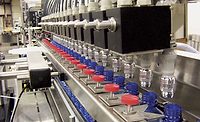What’s Needed to Maintain Safety and Product Integrity in the Paint Industry

Like any other industry, the paint industry has specific requirements in place for packaging, including requirements for both safety and product integrity. Certain types of liquid filling equipment are capable of meeting these criteria and maximizing efficiency throughout the entire packaging process.
Safety Measures in the Paint Packaging Process
Most paint products are highly flammable liquids, requiring filling equipment and processes that prevent combustion, along with proper sealing techniques and reliable materials that will prevent leakage and present a potential fire hazard.
Liquid paints can include a variety of products, including paint, lacquer, stain, varnish, enamel, liquid filler, liquid lacquer base and shellac solutions. Other paint-related materials could include paint thinners, dryers, removers or reduction compounds. All of these and other flammable liquids will require packaging machines (including fillers) that can safely handle these products.
Many solvent-based paint products are also highly toxic and can present a health hazard due to fumes, which packaging systems can prevent with sufficient sealing materials and equipment.
Packaging machines for paints should ultimately keep the entire process safe while properly packaging all products to prepare them for transportation and a long shelf life.
One of the best ways to determine the types of safety hazards that paint products pose is to review the supplier’s Safety Data Sheet. Suppliers can also provide additional details about chemical properties and potential hazards.
Product Integrity for Paints
Paints also require packaging that can keep them from drying, leaking or spilling at any point. Filling machines designed to work with paint cans and lids can properly handle these products.
Proper seals will help preserve the contents contained and preserve the product’s integrity. To help maintain product integrity throughout the entire production process, it’s important to make sure that the sealing process is consistent, using top-quality sealing materials and equipment.
Maintaining a Consistent Environment
Many paint products require a specific type of environment to avoid safety risks and preserve the overall effectiveness of the product. Certain products are more vulnerable to damage and a general decrease in quality if a specific temperature isn’t maintained, or if they’re inadvertently mixed with contaminants or other chemicals throughout the packaging or storing process. For instance, water-based paints tend to develop a gelatinous consistency in below-freezing temperatures, while paints in higher temperatures may also experience a change in viscosity.
The potential risk of product wastage or workplace injury makes it necessary to maintain the ideal environment for the packaging of these products from start to finish. One of the best ways to help facilitate this is to use the appropriate liquid packaging machines for the application.
Maintaining the right type of environment for these products can also ultimately help facilities save money in the long run with less waste.
Types of Liquid Packaging Equipment Needed for Safety and Product Integrity
Depending on the specific needs for each paint product, including the viscosity level, there are plenty of different liquid packaging machines that are suitable for these production lines.
Liquid Fillers
There are multiple types of liquid filling machines that paint packaging systems can use, including:
Gravity Fillers
Both gravity and pressure/gravity fillers are ideal for liquids of water-thin to medium viscosity. However, pressure/gravity fillers will typically be used for thicker liquids, while gravity fillers tend to be used for thinner or foamy liquids.
These fillers operate using gravity to fill the liquid based on its specific weight. Pressure/gravity fillers, on the other hand, will use a combination of applied pressure and gravity to fill more viscous liquids. For other thicker liquids, certain other filling machines will use additional pressure to fill containers.
Piston Fillers
These accurate and repeatable volumetric piston fillers are used for filling many different liquids and containers at specific volume settings. However, they are generally used for more viscous products.
Piston fillers use a turning rotary valve that turns to allow liquids to flow into the cylinder from the hopper, and a piston is then used to pull the product into the cylinder until the cylinder is completely filled. Once the cylinder is filled, the rotary valve will change position to allow the piston to push the liquid product into a container below.
Pump Fillers
Pump liquid fillers are designed for quick installation in low- to medium-speed production lines, and they are compatible with liquids of varying viscosities. They fill a specific volume of product for each container for maximum accuracy, which makes these ideal for high-value products.
Pump fillers will utilize individual pumps for each of the filler’s filling heads, and can come in a variety of different styles with different capacities, depending on the needs of the application.
Using one or more of these liquid fillers can help meet all company-wide and industry standards for paint packaging. The type of machine used will ultimately depend on the viscosity level, production volume and speed, and type of container used for the paint product.
Rinsers
Before the filling process even begins, containers for paint products need to be clean and clear of particles and other contaminants that could compromise the integrity of the product. Through the use of rinsers, including water or air rinsers, production lines can effectively clean all containers prior to filling and prevent product spoilage.
Conveyors
There are different types of conveyors for various products, but paint products will normally benefit from the use of standard conveyors that utilize the right speed settings. A system of conveyors will be able to carry a wide variety of paint containers safely and efficiently throughout the packaging cycle.
Using a system of each of these packaging machines can help avoid safety violations while ensuring that the product is properly filled packaged to maintain quality.
Sealers and Cappers
High-quality sealing equipment is also required to seal paint cans and other types of paint containers. For paint products that use bottles with caps, capping machines will be required for proper application and sealing of caps.
Pluggers, chuck cappers, snap cappers and spindle cappers are available for capping applications, with certain accessories to enhance productivity such as cap elevators, sorters and pre-feeders.
Dust Removal Systems
The combustibility of many paint products makes dust removal systems necessary in many cases. A buildup of metal and organic dusts can be ignited and generate a de-flagration if dispersal in the air occurs at any time.
Even if these materials aren’t typically combustible, the right combination of concentration, particle size and presence of a source of ignition can create dangerous deflagrations.
Using a system of one or more dust removal machines in a facility can help prevent the buildup of combustible particulate and keep the packaging process safer.
Consulting with Experts for the Right Equipment
With the help of knowledgeable and experienced professionals, you can find the right liquid filling equipment and other packaging facility equipment for paint products of all types. Manufacturers and suppliers of packaging machines can help you determine what you need for your specific application, whether you need one or two filling machines, or a complete packaging system to meet all industry standards.
The right packaging machine company will be able to assist in machine selection and provide professional installation to ensure you get the most from your machinery.
The Need for Preventative Maintenance
In addition to high-quality packaging equipment and professional installation, it’s important to make sure that machinery continues to work the way it should, or it could result in poor-quality product or present safety hazards due to improper handling.
The best way to avoid these issues is to perform regular preventative maintenance that keeps all liquid fillers and other machinery working optimally. Doing so will also help reduce the costs of more extensive repairs and replacement of equipment.
A reliable supplier of liquid packaging machinery should offer preventative maintenance and support services to help you get consistent results. A good supplier will also provide training services to ensure your in-house staff understand how each machine operates and know what to look for to perform basic troubleshooting for various issues.
Maximizing Productivity and Cost-Effectiveness Through Compliance
By installing the right fillers and other equipment in your facility to meet all safety and product quality standards, you can benefit from optimum efficiency of production and reduced expenses. Your production line will be able to give you the results you want while avoiding all of the potential risks that might otherwise result in product loss and employee injury.
Looking for a reprint of this article?
From high-res PDFs to custom plaques, order your copy today!








